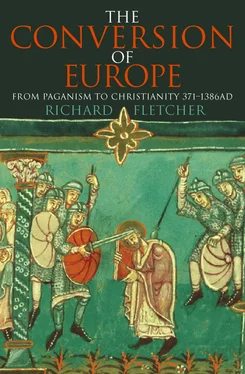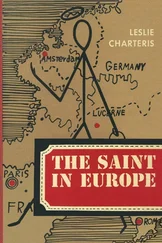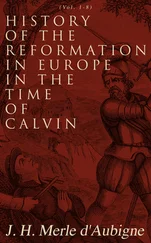1 ...6 7 8 10 11 12 ...40 This Eusebian accommodation between church and empire became and long remained a cornerstone of the ‘political theology’ of the eastern empire and its successors. For the historian of conversion it has two significant implications. If empire and church are moving towards identity, if they are (in the words of another scholar) but ‘two facets of a single reality’, then one of the questions from which we started – Who is Christianity for? – acquires at once a sharper urgency and an answer. If Romanitas and Christianitas are co-terminous, then the faith is for all dwellers within the ring-fence of the empire but not for those outside. All dwellers within means the ‘internal outsiders’, the huge rural majority, whose evangelization will occupy us in the next chapter. Those outside means the barbarians.
Barbarians could be as effectively de-humanized by the educated minority as were the peasantry. ‘Roman and barbarian are as distinct one from the other as are four-footed beasts from humans,’ wrote the Spanish Christian poet Prudentius in about 390. His contemporary St Jerome was sure that some of the Germans were cannibals. ‘The holy priesthood, chastity and virginity do not exist among barbarian peoples; and if they were to do so, they would not be safe,’ wrote Bishop Optatus of Milevis in north Africa in the 360s. Ingrained habits of thought are revealed in the turn of a phrase. The Spanish historian Orosius, writing in about 417, could begin a sentence with the words ‘As a Christian and as a Roman …’ Quite so. 5 The identities were conflated. In such a climate of opinion there could be no question of taking the faith to the heathen barbarian. In the words of a leading modern authority, ‘Throughout the whole period of the Roman empire not a single example is known of a man who was appointed bishop with the specific task of going beyond the frontier to a wholly pagan region in order to convert the barbarians living there.’ 6
One qualification needs to be made. If Christian communities came into existence outside the imperial frontiers they might request the church authorities within the empire to send them a bishop to minister to their needs. There was a variety of ways in which such communities might come into existence, by means of trading settlements, diplomatic contacts, veterans returning from service in the Roman army in the course of which they had been converted, cross-frontier marriage, the settlement of prisoners carried away from their homelands by barbarian raids, and so on. Here is an example. At the end of the fourth century Rufinus of Aquileia translated Eusebius’ Ecclesiastical History from Greek into Latin to render it accessible to the Latin-speaking west. He also brought it up to date, continuing it from where Eusebius had left off in Constantine’s day down to the death of the Emperor Theodosius I in 395. Rufinus had met the king of Georgia, in the southern Caucasus, who told him that his predecessor King Miriam, who reigned in the time of Constantine, had acquired a Christian slave-girl who had converted her master to Christianity. Rufinus did not know her name, though later sources were to name her as Nounè or Nino. Whatever may lie behind this story – perhaps a jumbled memory of diplomatic relations between Constantinople and Tiflis – we may be certain that Christian communities did exist in Georgia in Constantine’s reign, because reliable sources reveal that a certain Patrophilus, bishop of Pithyonta (Pitsunda), attended the ecclesiastical council of Nicaea in 325. The site of his bishopric on the Black Sea coast at the foot of the Caucasus suggests that maritime contacts with the Roman empire had given rise to the Christian community over which he presided. We shall examine some further instances of these extra-imperial communities in Chapter 3.
However, the Eusebian accommodation would not commend itself in all quarters. It would be looked upon with disfavour by those of the ‘gathered’ tradition. It was persons of this persuasion, largely if not exclusively, who were responsible for perhaps the most remarkable phenomenon of late-antique Christianity – the growth of monasticism. Withdrawal from the world by an individual to a life of ascetic renunciation and self-denial in a desert solitude had an obvious biblical precedent in John the Baptist. The gospel stories of the temptation of Jesus reinforced the notion that the desert, the wilderness, was the place where the truly committed might test their faith and overcome the wiles of the Devil. It was in the valley of the Nile, where the desert and the sown lie so close together, that Christian solitaries first made their appearance. The most famous of these early hermits was Antony, a Coptic peasant who ‘dropped out’ of his village community at the age of twenty, in about the year 270, and for the remainder of a very long life gave himself over to prayer and asceticism. His example was infectious. Though he retreated ever deeper into the desert he was pursued by disciples eager to follow his example and receive his spiritual guidance. It was to one of these followers, Pachomius – perhaps significantly, an ex-soldier – that there occurred in about 320 the idea that communities of ascetics might be organized, living a common life of strict discipline according to a written rule of life. Thus was monasticism born.
It spread like wildfire in the fourth century. In part this was perhaps because, in a church now at peace after the Constantinian revolution, ascetic monasticism offered a means of self-sacrifice which was the nearest thing to martyrdom in a world where martyrs were no longer being made. In part the call of the ascetic life could be interpreted as a movement of revulsion from what many saw as the increasing worldliness of the fourth-century church, the merging of its hierarchy with the ‘establishment’, its ever-accumulating wealth, the growing burden of administrative responsibilities which encroached upon spiritual ministry. Monasticism offered, or demanded, a manner of life in which individualism had to be shed. To be ‘of one heart and of one soul’ within a community, to have ‘all things common’, was not simply to follow the example of the apostles commended in Acts iv.32: it was also to be liberated from the insidious temptation of private cares, selfish anxieties. Such liberation offered the possibility to humans of building a heavenly society upon earth. The monastic vocation was a call to a new way of apprehending, even of merging into, the divine.
Its appeal was made the more seductive by some persuasive advocates. A Life of St Antony was composed by Athanasius, the great bishop of Alexandria, in 357. It is one of the classics of Christian hagiography. Its speedy translation from Greek into Latin made it accessible in the western provinces of the empire. By a happy chance there has survived a vivid account of the effect this work had upon a pair of rising civil servants in the early 380s.
Ponticianus continued to talk and we listened in silence. Eventually he told us of the time when he and three of his companions were at Trier. One afternoon, when the emperor was watching the games in the circus, they went out to stroll in the gardens near the city walls. They became separated into two groups, Ponticianus and one of the others remaining together while the other two went off by themselves. As they wandered on, the second pair came to a house which was occupied by some servants of God, men poor in spirit, to whom the kingdom of heaven belongs. In the house they found a book containing the life of Antony. One of them began to read it and was so fascinated and thrilled by the story that even before he had finished reading he conceived the idea of taking upon himself the same kind of life and abandoning his career in the world – both he and his friend were officials in the service of the state – in order to become a servant of God. All at once he was filled with the love of holiness. Angry with himself and full of remorse, he looked at his friend and said, ‘What do we hope to gain by all the efforts we make? What are we looking for? What is our purpose in serving the state? Can we hope for anything better at court than to be the emperor’s friends? … But if I wish, I can become the friend of God at this very moment.’ After saying this he turned back to the book, labouring under the pain of the new life that was taking birth in him. He read on, and in his heart a change was taking place. His mind was being divested of the world, as could presently be seen … He said to his friend, ‘I have torn myself free from all our ambitions and have decided to serve God. From this very moment, here and now, I shall start to serve him. If you will not follow my lead, do not stand in my way.’ The other answered that he would stand by his comrade, for such service was glorious and the reward was great … 7
Читать дальше












